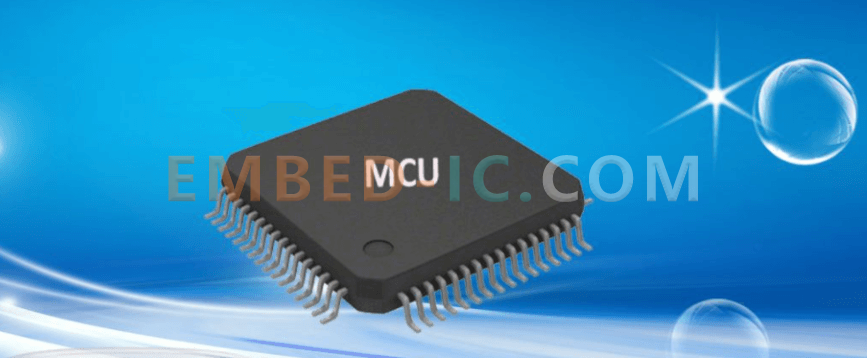
MCU, referred to as Microcontroller Unit. a chip-level computer formed by integrating CPU, memory (RAM and ROM), and multiple I/O interfaces on a chip.
CPU: Including arithmetic unit, controller and register group. It is the core component inside the MCU, which consists of two parts: arithmetic component and control component.
The former can complete data arithmetic and logic operations, bit variable processing and data transfer operations, while the latter coordinate work according to a certain time sequence and is a component for analyzing and executing instructions.
Memory: Including ROM and RAM. ROM program memory, the work of the MCU is executed one by one according to the pre-programmed program. The ROM program memory is used to store the programmed program (the system program is programmed and written by the manufacturer).
The stored data will not disappear after power failure. ROM is divided into on-chip memory and off-chip (extended) memory.
RAM data memory, data can be written at any time during program operation, and data can be read at any time. Stored data cannot be retained after power failure. RAM is also divided into on-chip data memory and off-chip (extended) memory
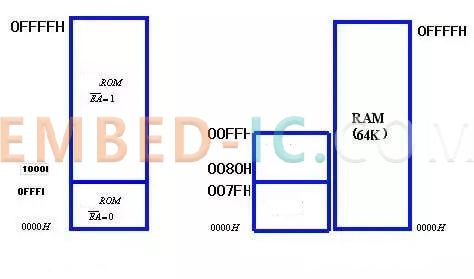
I/O interface: connect with external input and output (circuit) equipment. Digital I/O interfaces such as PO/P1/P2/P3, and internal circuits include port latches, output drivers and input buffers.
Uses of 4-bit, 8-bit, 16-bit, 32-bit, 64-bit MCU
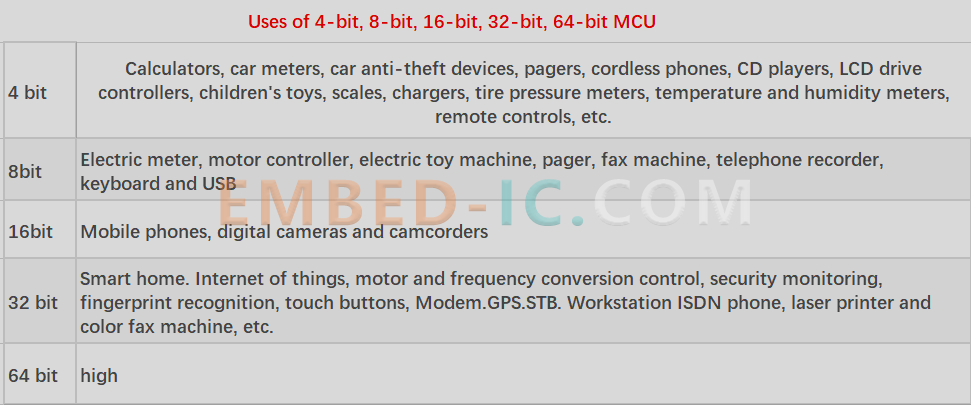
IoT driven
The rise of the Internet of Things industry is a major driving force for the development of MCUs. For example, medical electronic products, personal health monitoring products, etc. all require products with low power consumption, long-term use, and wireless communication, but these must be realized by the MCU.
As the core component of the Internet of Things, MCU has been further developed in terms of market size and technical requirements.

32bit MCU becomes mainstream
Early MCU architectures were mostly 8-bit (such as Intel 8051 series, Atmel AT8/TS8 series, Labs EFM8 series, etc.), and the integrated development environment (IDE) was also 8-bit.
With the complexity of tasks in the Internet of Things era, the increasing computing power has prompted MCUs to start to design 16 or 32 bits. At the same time, the related software development environment has also been upgraded to 32 bits, and even backward compatible. Let the development environment not be limited to hardware to provide more flexible development space.
Low power consumption becomes core competitiveness
At present, the most criticized point of various mobile electronic products on the market is that they need to be charged frequently. Various smart phone / bracelet manufacturers are working hard to reduce power consumption and improve battery life.
The limitation of power consumption makes many functions sacrificed during product design. For the larger number of wireless sensor nodes in the IoT world, power consumption and battery life are directly related to the feasibility of the product.
For example, the sensor nodes scattered in bridges or tunnels for detecting displacement and deformation are large in number and can only be powered by batteries. The battery life is usually more than ten years, which puts very strict requirements on the power consumption of the MCU.
How to achieve higher computing power under the premise of low power consumption has become a difficult problem for MCU manufacturers. At present, almost all mainstream manufacturers are aiming at this market demand and have launched their own ultra-low power MCUs.
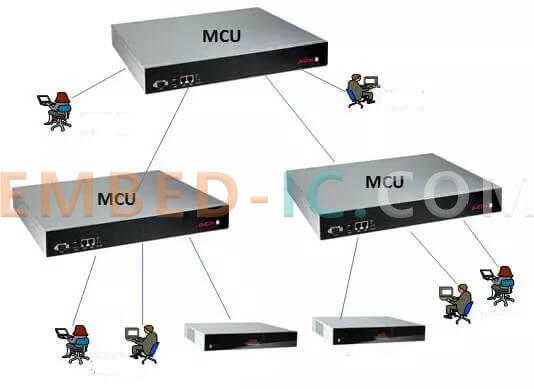
Highly integrated MCU+ becomes a trend
The ideal requirement of the Internet of Things for each node is intelligence, that is, it can sense external information through sensors, perform data operations through processors, and send/receive data through wireless communication modules.
Therefore, the solution of integrating sensor + MCU + wireless module is always the pursuit of various MCU manufacturers. What's more, for some sensor types that are relatively easy to integrate, such as touch screen controllers, accelerometers, gyroscopes, etc., some powerful manufacturers have implemented single-chip SOC/SIP integrated with MCUs.
Of course, due to the diversity of sensors and wireless communication technologies, and the differences in process technology, blindly integrating SIP or SOC may not be a wise move (such as gas sensors, temperature and humidity sensor integration solutions are more difficult), but manufacturers provide The overall solution of MCU+ has become an inevitable trend without a doubt.
market situation
Beginning in 2015, in order to compete for market share and deploy strong growth in IoT applications, several large-scale mergers and acquisitions occurred among major MCU manufacturers.
According to the statistics of the market research organization IC Insights, from the sales data after the merger and acquisition, the sales of the MCU product lines of NXP, Microchip and Cypress increased significantly year-on-year in 2016, and the rankings rose accordingly.
The MCU manufacturers that have not made large-scale acquisitions have shown mediocre performance, with only single-digit growth, such as ST and TI, and some have seen substantial declines, such as Samsung.
Figure: 2016 global MCU market structure
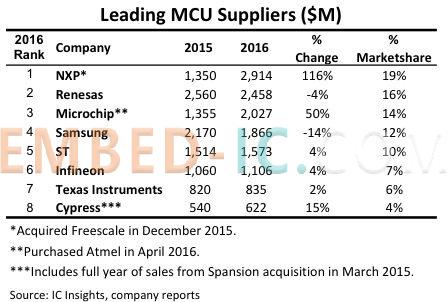
From the above figure, we can also see that the total global market share of the eight major MCU manufacturers has reached 88%, which means that in addition to a few major MCUs, the market share of small MCU companies is very small.
IC Insights research report said that the MCU market will reach its peak in 2020, with sales reaching US$20.9 billion and sales of 26.7 billion chips.
In response to such a market situation, ST has set itself a goal of reaching US$4 billion in sales in 2020, increasing its market share from the current 10% to 20%.
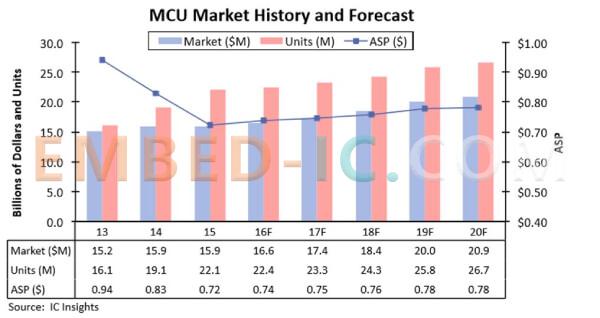
1.NXP
The traditional MCU of NXP (NXP) is based on the 80C51 core MCU, which embeds the functions of power-down detection, simulation and on-chip RC oscillator, which makes 51LPC in the application design of high integration, low cost and low power It can meet various performance requirements. In 2015, 75% of NXP's MCU revenue came from 8-bit and 16-bit MCUs used in smart cards.
After acquiring Freescale, NXP moved from the sixth largest MCU supplier in the world in 2015 to the top of the list, with a market share of 19% and a revenue of $2.9 billion. After the acquisition of Freescale, NXP's MCU turned to 32-bit MCU embedded control applications, and the automotive electronics field is its focus. Both NXP and Freescale have developed a large number of 32-bit ARM Cortex-M MCUs.
2. Renesas
The world's leading MCU supplier, the king of MCUs worthy of the name.
On April 1, 2003, Hitachi and Mitsubishi Electric carried out business reorganization and established Renesas Technology. In 2010, Renesas Technology integrated with NEC to form a new Renesas Electronics.
The newly born Renesas Electronics actively promotes and strengthens the development of the three major product areas of MCU, system LSI, analog and power semiconductor devices based on strong R&D capabilities, design and development platforms, and multiple manufacturing technologies.
3. Microchip (acquired Atmel)
The world's leading supplier of microcontrollers and analog semiconductors. Occupying the first place from 2006 to 2009. On January 19, 2016, Microchip successfully got married from Dialog and announced the successful acquisition of Atmel, with a total value of 3.56 billion US dollars.
Microchip, which successfully acquired Atmel, climbed to the third position in the MCU market in less than two months.
4. Samsung
Samsung's MCU market share in 2016 was 12%, ranking fourth. Samsung has KS51 and KS57 series 4-bit MCUs, KS86 and KS88 series 8-bit MCUs, KS17 series 16-bit MCUs and KS32 series 32-bit MCUs. Samsung MCU is OTP type ISP on-chip programming function. NEC technology is used on 4-bit machines, Z8 technology from Zilog is introduced on 8-bit machines, and ARM7 cores are purchased on 32-bit machines, as well as DEC technology and Toshiba technology. The price of its single-chip die is quite competitive.
5. ST
Established in June 1988, it was formed by the merger of Italian SGS Microelectronics and French Thomson Semiconductor. In May 1998, SGS-THOMSON Microelectronics changed its company name to STMicroelectronics Co., Ltd. STMicroelectronics is a global leader in the development and provision of semiconductor solutions in the field of microelectronics applications. The STM32 series of ARM Cortex-M* microcontrollers occupies half of the industry.
6. Infineon
One of the few automotive semiconductor manufacturers that can fully cover the most important applications in the automotive field.
It was established in Munich, Germany in April 1999. It was formerly the semiconductor division of Siemens Group. It became independent in 1999 and went public in 2000. It has a broad product portfolio, including microcontrollers, smart sensors, RF transceiver ICs, radars, and discrete and integrated power semiconductors. MCU is very well-known in automotive electronics, industrial control, and medical fields.
7. TI
A global semiconductor design and manufacturing company with business covering more than 35 countries, serving more than 100,000 customers around the world, with 85 years of innovation history, more than 100,000 analog integrated circuits, embedded processors, software and tools, The largest sales and support team.
TI's MSP320 was once a popular digital integrated circuit. Later, with the company's transformation, MCU began to decline. Now, with the introduction of new products, TI's MCU is making a comeback.
8. Cypress+Spansion
Cypress was established in 1982. The company produces high-performance IC products for data transmission, remote communication, PC and military systems, and is listed on the New York Stock Exchange. On March 12, 2015, Cypress Semiconductor and Spansion announced that the two companies' $5 billion all-stock tax-free merger transaction has been completed. This merger gave birth to a global market leader in MCU and embedded system dedicated memory with a turnover of US$2 billion, and automotive MCU and memory ranked third.
Manufacturer: Texas Instruments
IC DSP FIXED-POINT 688FCBGA
Product Categories: DSP
Lifecycle:
RoHS:
Manufacturer: Texas Instruments
IC DSP MILTICORE 561FCBGA
Product Categories: DSP
Lifecycle:
RoHS:
Manufacturer: Texas Instruments
IC DSP FIX/FLOAT POINT 361NFBGA
Product Categories: DSP
Lifecycle:
RoHS:
Manufacturer: Microchip
IC MCU 8BIT 64KB FLASH 28SDIP
Product Categories: 8bit MCU
Lifecycle:
RoHS:
Looking forward to your comment
Comment